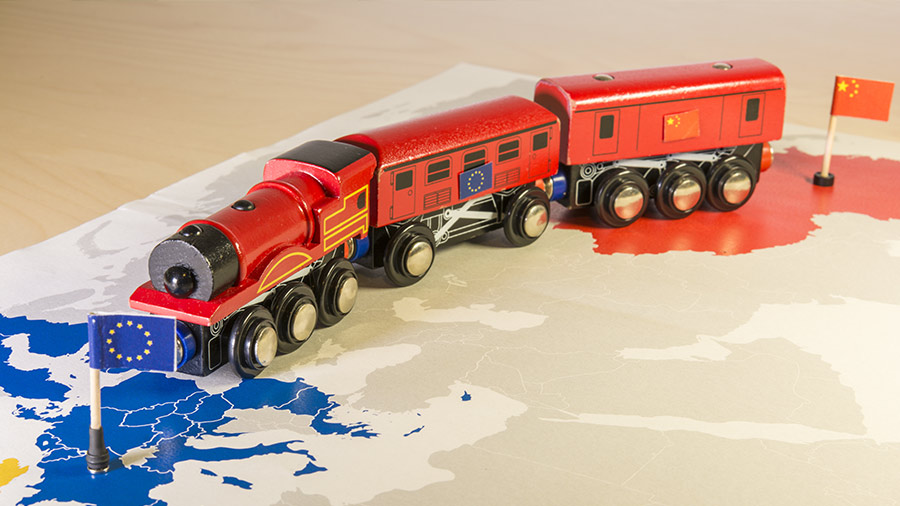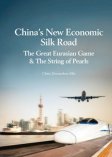EU Position Paper on Europe – Asia Connectivity Doesn’t Mention China’s Belt and Road Initiative


The European Commission has just released a report “Connecting Europe and Asia – Building blocks for an EU Strategy” within which it lays out a basic framework for “a strategy on connecting Europe and Asia.”
In the document are numerous passages highlighting the successes the EU has already had, and loosely describes future potential for dialogue with “Asian partners”. It also highlights the amount of trade the EU has with Asia, (without specifying what it means by “Asia”). It states: “The relationship between the European Union and Asia is of global significance and the ties are likely to increase in the coming years. Asia, with roughly 60 percent of the world population accounts for 35 percent of the EU’s exports (€618bn) and 45 percent of the EU’s imports (€774bn)”.
These are huge figures and should, from the trade perspective, garner serious interest from EU businesses and institutions focusing on sourcing talent, commodities, technology, and products from Asia, and EU based export businesses with products they wish to sell to Asia. Which as the report itself suggests, is a market destined to grow.
In laying out its case for investing in Asia, the report notes that “Some estimate that Asia will require over 1.3 trillion EUR a year of infrastructure investment in the coming decades to maintain today’s growth rates and to adapt to climate change. By comparison, in the EU, the investment in the Trans-European network for transport is estimated to require 1.5 trillion EUR in the period 2021-2030.”
In short, it sees that infrastructure in the EU itself has a larger financial need than Asia. On that premise, the basic premise of the report in terms of promoting the need for greater connectivity with Asia essentially fails.
What it does do is make rather a bland statement that the EU sees an opportunity in Asia for “increased cooperation, peaceful political cooperation, fair and stronger economic relations, comprehensive societal dialogue and collaboration on international and regional security.”
Despite the manner in which global media have promoted the report, (see here, here, and here for examples) the paper provides no suggestions on how the EU can connect with Asia. It does not offer an “alternative” and certainly not, as has been reported elsewhere in the media “an answer to China’s Belt & Road Initiative.” In fact, the report mentions China just twice, doesn’t mention the BRI at all, and only refers to Russia, with which the EU shares a 2,307 km border and is a major transit route into Asia, as a “dialogue partner” as it does with Turkey. India too, only warrents a minor reference. ASEAN isn’t mentioned in any connectivity context, while the report completely ignores the Eurasian Economic Union, the European Union’s equivalent in Asia, which nudges up to the EU’s borders at Belarus.
Instead, the report focuses on developments and connectivity in countries of the Western Balkans and Caucasus, none of which are members of the EU. Of these, the report mentions the Trans-European Network for Transport (TEN-T) which has recently been extended to include the ex-Soviet states of Armenia, Azerbaijan, Belarus, Georgia, Moldova, and the Ukraine. The Western Balkans are also loosely mentioned in the same context, countries which are generally considered to include Albania, Bosnia & Herzegovenia, Kosovo, Macedonia, Moldova, Montenegro & Serbia.
It is of some significance, however, that the report downplays any detailed mention of Russia, despite these mostly being ex-Soviet states. Having traveled extensively throughout the region, I can advise that as a result of this historical quirk, these countries do not necessarily think the same way as Western Europe, while Azerbaijan is Muslim. Turkish influence also looms large in some of these countries, while like Russia, there is scant mention of the country nor any comment whatsoever about providing any connectivity to either. Referring to Russia and Turkey as “dialogue” rather than connectivity partners from an EU Commission report on developing ties with Asia therefore reveals the EU Commissions report true goal: the development of influence into the Balkans and the Caucasus.
There are dangers here. Not least the situation concerning Moscow, which will be alarmed at the EU casting eyes on yet more ex-Soviet territories. There are already border disputes in Georgia, and an unofficial war in Eastern Ukraine, partially sparked by talks of EU membership and subsequent NATO admission as a result. Deepening this would be problematic. In fact, one wonders why the EU Commission feels it can target “connectivity” and political influence over such countries when it has demonstrably failed to do so with Russia itself.
The only part of “Asia” specifically mentioned in any connectivity detail in the report are the Balkan and Caucasus countries. But doing so without factoring in the Russian and Turkish positions is a serious and foolish omission.
The report also suggests “doing things the European way” which are identified as being “the free flow of people, goods, services and capital. EU-wide rules – such as EU state aid control and procurement rules – ensure fair and transparent competition, whilst Union policies also ensure environmental protection, safety, security, as well as social and individual rights.” Quite how EU voters would regard the free movement of more peoples into the EU is not addressed. Concerning the “rules” section of transparency laid out above, this can be translated as “EU companies must participate and you must adhere to rules set by the EU. This is regardless of your own rules and financing” – which has already been the case in the controversial, China-funded Budapest-Belgrade rail project. Instead, the EU Commission deliberately ignores other trade blocs or countries own regulatory guidelines, when a better approach would be to work with them.
The procurement transparency issue mentioned is also somewhat ironic when the EU allows MEP’s to submit a monthly €4,416 monthly “general expenditure allowance” without the need for them to submit receipts or invoices, a total expenditure of over €40 million a year from EU budgets. A recent, independent investigation of MEP’s expenses claims found 249 “ghost offices”, where MEPs had no office or refused to divulge the address. Yet, the EU insists on total transparency in contracts with non-EU contractors. It appears one rule for the EU, and another for everyone else. It is arrogant and unhelpful.
The report goes on to mention developments with Asia in Air, Sea and Land Transport, again without any concrete specifics other than the TEN-T rail network mentioned earlier, and within the Black Sea, which again requires liaison with Russia and Turkey but is not mentioned.
China, a large EU trade partner and major Asian nation, is mentioned only in the following context: “Bilateral cooperation with individual countries should be adapted to their specific situation. For instance, with China, the EU should strengthen the existing cooperation on the respective infrastructure and development cooperation initiatives, promote the implementation of the principles of market access and a level playing field, as well as rely on international standards within initiatives on connectivity.” There is no other mention of actual connectivity other than a nod to “agreeing air safety standards”. India, too, is largely omitted while the Belt and Road Initiative is completely ignored.
The lack of attention paid to China is especially worrying; the country has recently signed a Free Trade Agreement with the Eurasian Economic Union, which includes Armenia and Belarus. Armenia is being targeted by the EU as a potential member state, while Belarus borders three EU countries. While the China-EAEU FTA is non-preferential, changes to it could see Chinese goods arrive, duty free right up against the EU border. Yet the report contains no mention of any connectivity with the PRC or with the EAEU.
What it does do is a strange type of Asian cherry picking, stating “the EU should expand the dialogue on sustainable connectivity with other partners including Afghanistan, India, Indonesia, Iran, Pakistan, Russia, Republic of Korea, Turkey, and countries of Central Asia, as well as Australia and the United States.”
The EU Commission then discusses financing of this “connectivity with Asia”, stating that it doesn’t intend to actually make any recommendations: “The Commission does not aim at establishing an investment plan, although the EU’s existing and future financial instruments could offer some perspectives for supporting private investment in connectivity-related projects.”
So, the Commission proposes achieving EU-Asian connectivity without any money. That’s novel. Instead, the Commission suggests raiding the public purse and targeting private investors: “The EU should strengthen cooperation with the EU Member States’ public and private finance institutions, including sovereign funds and strive towards a closer concentration of activities with them.”
The EU Commission then summarizes the report as follows: “This Joint Communication provides the basis for an EU strategy on connecting Europe and Asia. The principles of sustainable, comprehensive and international rules-based connectivity inform this strategy. Through this approach, the EU will enhance regulatory quality and level playing field of connectivity, drawing inspiration from its internal market. It will contribute to the development of transport, energy and digital networks, on the basis of its experience with cross-border connectivity. It will seek to strengthen its partnerships with third countries, regions and international organisations. It will increase cooperation in education, research, innovation, culture, sport and tourism, helping to promote diversity and the free flow of ideas. To support these different policies and actions, the EU should use all levers and tools in its financial framework to mobilize public and private investment in sustainable connectivity.”
These are nice words. But the report in no conceivable way offers any blue print for “EU connectivity with Asia”, and neither does it offer any dialogue, co-operation or infrastructure development with the very nations the EU needs to properly connect with Asia: Russia, Turkey, India, and China.
It is not a blueprint for EU-Asia connectivity and it is not an “answer to China’s Belt & Road.” In fact, the report offers very little of substance other than stating a desire to be more involved with the Western Balkans and the Caucasus. That’s a very strange way of addressing “Asian connectivity”.
About Us
Chris Devonshire-Ellis is the Chairman of Dezan Shira & Associates and Publisher of the Asia Briefing series of titles. He can be reached at chris@dezshira.com.
 Related Reading:
Related Reading:
![]() A Brave New World: China, Russia, and ASEAN Lead Eurasian Free Trade
A Brave New World: China, Russia, and ASEAN Lead Eurasian Free Trade
![]() China Moves in on Balkans after EU Promotes “Connectivity” rather than Membership
China Moves in on Balkans after EU Promotes “Connectivity” rather than Membership
![]() Transhipping China Trains and Ships to Europe – Understanding Russia’s Economic and Trade Performance in 2018 and Beyond
Transhipping China Trains and Ships to Europe – Understanding Russia’s Economic and Trade Performance in 2018 and Beyond
![]() Turkeys Pivotal Role in China’s Belt and Road Initiative with Europe, Central Asia, and the Middle East
Turkeys Pivotal Role in China’s Belt and Road Initiative with Europe, Central Asia, and the Middle East
China’s New Economic Silk Road
This unique and currently only available study into the proposed Silk Road Economic Belt examines the institutional, financial and infrastructure projects that are currently underway and in the planning stage across the entire region. Covering over 60 countries, this book explores the regional reforms, potential problems, opportunities and longer term impact that the Silk Road will have upon Asia, Africa, the Middle East, Europe and the United States.






